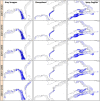Projecting shifts in thermal habitat for 686 species on the North American continental shelf
- PMID: 29768423
- PMCID: PMC5955691
- DOI: 10.1371/journal.pone.0196127
Projecting shifts in thermal habitat for 686 species on the North American continental shelf
Abstract
Recent shifts in the geographic distribution of marine species have been linked to shifts in preferred thermal habitats. These shifts in distribution have already posed challenges for living marine resource management, and there is a strong need for projections of how species might be impacted by future changes in ocean temperatures during the 21st century. We modeled thermal habitat for 686 marine species in the Atlantic and Pacific oceans using long-term ecological survey data from the North American continental shelves. These habitat models were coupled to output from sixteen general circulation models that were run under high (RCP 8.5) and low (RCP 2.6) future greenhouse gas emission scenarios over the 21st century to produce 32 possible future outcomes for each species. The models generally agreed on the magnitude and direction of future shifts for some species (448 or 429 under RCP 8.5 and RCP 2.6, respectively), but strongly disagreed for other species (116 or 120 respectively). This allowed us to identify species with more or less robust predictions. Future shifts in species distributions were generally poleward and followed the coastline, but also varied among regions and species. Species from the U.S. and Canadian west coast including the Gulf of Alaska had the highest projected magnitude shifts in distribution, and many species shifted more than 1000 km under the high greenhouse gas emissions scenario. Following a strong mitigation scenario consistent with the Paris Agreement would likely produce substantially smaller shifts and less disruption to marine management efforts. Our projections offer an important tool for identifying species, fisheries, and management efforts that are particularly vulnerable to climate change impacts.
Conflict of interest statement
Figures








References
-
- Sunday JM, Bates AE, Duty NK. Thermal tolerance and the global redistribution of animals. Nat Clim Chang. 2012; 2:686–690.
-
- Poloczanska ES, Brown CJ, Sydeman WJ, Kiessling W, Schoeman DS, Moore PJ, et al. Global imprint of climate change on marine life. Nat Clim Chang. 2013; 3:919–925.
-
- Pinsky ML, Worm B, Fogarty MJ, Sarmiento JL, Levin SA. Marine taxa track local climate velocities. Science. 2013; 341:1239–1242. doi: 10.1126/science.1239352 - DOI - PubMed
-
- Hettler WF. Correlation of winter temperature and landings of pink shrimp Penaeus duorarum in North Carolina. Fish Bull. 1992; 90:405–406.
Publication types
MeSH terms
Associated data
LinkOut - more resources
Full Text Sources
Other Literature Sources
Medical

